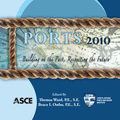LID Concepts for Container Terminals
Publication: Ports 2010: Building on the Past, Respecting the Future
Abstract
Low Impact Development (LID) techniques are becoming more common in site development as cities, states and private developers try to lessen the impact of stormwater runoff on the environment. These techniques are often incorporated to obtain LEED certification. Ports and terminal operators also have been seeking alternatives to the traditional construction practices to meet their environmental stewardship goals. The surge in LID use has broadened the experience of engineers and contractors and has made implementation more feasible. In the State of Washington, a recent ruling by the Pollution Control Hearings Board requires the use of low-impact development techniques by Municipalities where feasible. These mounting "green" goals and regulatory requirements warranted a fresh look at the practicality of implementing LID on port container facilities. This paper summarizes a study performed to aid the Port of Tacoma (Port) in evaluating the types of LID concepts that could feasibly be incorporated into a new container terminal development. The relative capital costs of these alternatives were evaluated and weighed against the operational constraints and the anticipated life cycle costs. Concepts that met the needs of both the Port and the terminal operator were carried into design. Concepts that did not were shelved with the understanding that a change in the terminal's operating mode could significantly change the viability of one or more of those alternatives. This evaluation allowed the Port to assure the reviewing agencies and the public that every practical LID alternative was being considered and, where practical, implemented, consistent with the Port's commitment to environmental stewardship. An example of an LID concept evaluated is the use of pervious pavement in the container yard. The study evaluated the properties of several types of pervious pavements and developed the cost differences while also identifying the types of equipment that could be accommodated. Could top-picks be operated across the pavement, or just trucks? How could pervious pavements be used over contaminated soils? How could the pavement be protected from damage by container corner castings? Does the pavement provide water quality treatment? These answers would be used to guide the project design and establish a baseline for future port water quality design.
Get full access to this article
View all available purchase options and get full access to this chapter.
Information & Authors
Information
Published In
Copyright
© 2010 American Society of Civil Engineers.
History
Published online: Apr 26, 2012
ASCE Technical Topics:
- Benefit cost ratios
- Business management
- Container shipping
- Environmental engineering
- Financial management
- Freight transportation
- Hydraulic engineering
- Hydraulic structures
- Infrastructure
- Pavements
- Pollution
- Ports and harbors
- Practice and Profession
- Sustainable development
- Transportation engineering
- Water and water resources
- Water quality
- Water treatment
Authors
Metrics & Citations
Metrics
Citations
Download citation
If you have the appropriate software installed, you can download article citation data to the citation manager of your choice. Simply select your manager software from the list below and click Download.
